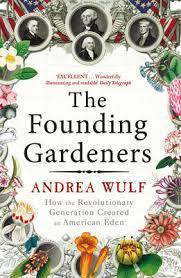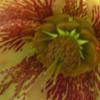
If you thought protecting natural species and the environmental movement was a 20th century phenomon then you would be wrong. According to Andrea Wulf in The Founding Gardeners, James Madison, the fourth President of the US, was way ahead of everyone else. In May 1818 in his Address to the Agriculture Society of Albemarle railed against “the excessive destruction of timber” and the affect of man increasing “certain plants an animals – crops and livestock – ‘beyond their natural amount’, thereby tipping the scales towards his own advantage.” Whilst Madison may not have been the first to talk about the destruction of the forest and conservation “he was the first politician (albeit a retired one0 to make a public speech about it,..”
The Founding Gardeners is a fascinating and engaging read. Andrea Wulf takes what could be a considerably dry subject – the early years of the United States and brings her four ‘Founding Gardeners’ alive. She demonstrates through a series of vignettes how Washington, Adams, Jefferson and Madison were passionate about ‘gardening’ of one form or another. She does however, warn us at the start that the term ‘gardening’ is used in the loosest sense through out the book and covers a range of activities from weeding a flower border to growing crops in vast plantations.
This book follows on from The Brother Gardeners in which Wulf explores the connections between the early plant hunters in the US and other colonies such as John Bartram and the keen plantsman back in the UK who commissioned the collecting such as Phillip Miller. The Founding Gardeners moves forward a little in time but shifts its focus to the US. Wulf shows how important agriculture was to the creation of the country we know now. The two party system evolved out of a disagreement between those who thought the country’s economy should be based around agriculture, the Republicans, and those who beleived that banking and trade was the US’s future, the Federalists. Even before this time Benjamin Franklin, a representative of the American colonies, was a key figure in encouraging the Founding Fathers to move for independent based on his belief that the US could be independent due to its ability to grow vast crops – it was essentially at this time the bread basket for Britain.
However, away from the political scene each of the four Founding Gardeners was passionate about plants and gardening. We learn that Adams and Jefferson went on a tour of English gardens to kill time while they were waiting for the British government to repay a loan. They visited Stowe but Jefferson was particularly taken with the idea of the ornamental farm which he saw at Wooburn Farm and The Leasowes. He was to later take this idea and develop it at Monticello, his own property in Virginia. I knew that Jefferson was a keen horticulturalist but I didn’t realize that Washington was as well. Like Franklin, Washington saw that America’s wealth was in its cultivated land but he also realised how important it was to preserve the country’s native flora. Wulf argues that whilst Franklin valued the country’s flora by how productive it was either through feeding the people or providing timber for fuel or building; Washington, being of a younger generation, “was also more susceptible to the sheer beauty of the American flora”. Just as Jefferson and Madison would do in later years Washington set out to plant only native species at his property and they all were clients of John Bartram’s nursery, now run by his sons. Adams, not being as wealthy as the other three, gardened on a more modest scale but he too set out to acquire land and planted orchards. He also thwarted Washington’s grandiose scheme for the gardens and parkland around the new White House in Washington opting instead for a more informal and smaller garden. Wulf describes how Adams struggled with the pressures of his Presidency and how creating the garden at the White House was more important to him than furnishing the interior as it was his way of dealing with the pressures of government.These are but a few of the stories that Wulf presents us with to show how Washington, Jefferson, Adams and Madison’s “passion for nature, plants, agriculture and gardens shaped the birth of America” and I have to say I found it a compelling read.Personally, I think Andrea Wulf is one of the most readable of garden historians. Her writing style flows well despite the factual content, she has an inate ability to bring the lead figures to life and you forget you are reading a factual account. Whilst she makes assumptions based on the sources she has researched she is clear and obvious when she is making these and there is no sense of feeling there is a hidden agenda or you are being talked down to. This post was not written as a result of receiving a review copy of the book. I bought it myself as I enjoyed her previous book so much and I have a passion for history as well as gardening. I would recommend The Founding Gardeners to anyone who shares my passions and I am sure that my gardening friends in the US would find it fascinating to discover that many of their approaches to gardening were shared by their Founding Fathers.

